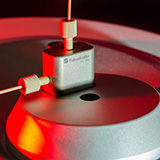Compact, continuous, cost effective: Fraunhofer ICT- IMM integrates NMR spectroscopy into the continuous production of fluorine fine chemicals.

Medical science today is better developed than ever and pharmaceutical companies are continuously working on innovations. The composition of medicines, their purity and of course their constant quality are of utmost importance. At this point NMR spectroscopy, one of the most important analytical methods of organic chemistry and a standard method for the structure elucidation of chemical compounds, may help.
Despite modern technology, NMR spectroscopy remains to be a complex method. It is maintenance intensive and with that cost intensive. Furthermore the typically used high-frequency devices are large, expensive and inflexible. Although they provide a high resolution in measuring, what is of immense importance particularly in proton spectroscopy, the handling of the probes is quite a lot of effort.
A continuous monitoring of a synthesis during the industrial production process of for example a drug is currently hard to realize. In doing so it would however be possible to continuously monitor the quality of an active ingredient and to intervene during the production process when it comes to variations.
Fraunhofer ICT-IMM and its partners have done an initial step in this direction within the international ContiNMR project. Together they have been developing a system for the continuous synthesis of fluorine fine chemicals with integrated on-line NMR analysis that can also be used for phosphorous compounds. Fluorine and phosphorous fine chemicals are essential components for pharmaceutical and agrochemical products and present an important market in the producing chemical industry. So far the scientists have managed the construction of a complete laboratory plant with microreactors, whose design allows the implementation of four different routes for the synthesis of fluorine chemicals. An integrated cartridge system enables the exchange and the renewal of the reagents. As an analytical platform the compact benchtop NMR spectrometer NMReadyTM 60 of the Canadian company Nanalysis Corp. is used. The necessary flow cells have been equipped with a control system based on magnetic valves. These allow to continuously fill the flow cell with reaction solution (conti measurement) or to bypass the solution at the spectrometer to achieve a more precise measurement (stopped-flow-measurement). The scientists are able to derive from the measurement information about the degree of implementation and therewith the quality of the solution as well as the structure by means of coupling patterns.
What started with extensive tests at ICT-IMM, is now continued on site of the partner Hansa Fine Chemicals GmbH. In the subsequent stage the system is operated with prepared solutions to analyze the quality of the spectra of simple and complex substances. Following tests shall then match the everyday usage of the plant for the synthesis of fluorine substances with integrated analysis.
Especially the stopped-flow approach combined with additive agents may help to NMR spectroscopically answer medium-term questions of enantiomer purity in the production process. This problem is well known from the contergan affair in the early sixties.
 Fraunhofer Institute for Microengineering and Microsystems IMM
Fraunhofer Institute for Microengineering and Microsystems IMM